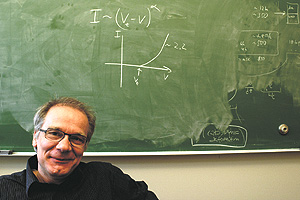Heinrich Jaeger, Professor in Physics and the College
By Steve KoppesNews Office
 Heinrich Jaeger | |
Galileo had the Leaning Tower of Pisa from which he allegedly conducted his famous experiment on the physics of falling objects. But when teaching introductory physics to undergraduates, Heinrich Jaeger settles for the Wobbly Maintenance Platform of Kersten instead.
Climbing aboard a motorized cherry-picker apparatus that provides workers access to the ceiling, Jaeger, Professor in Physics and the College, rises high above the lecture-hall floor in the Kersten Physics Teaching Center.
“By the time it reaches the lecture hall ceiling, the whole thing is very precarious, starts wobbling, and the instructor is in peril,” Jaeger jested.
Facing down his fear of heights, he leans over the platform and simultaneously drops a bowling ball and a smaller, lighter ball. Despite their differing masses, both balls hit a plank on the floor at the same time.
Such lecture demonstrations of physics in action have become a hallmark of the introductory courses that Jaeger has taught regularly since joining the Chicago faculty in 1991. Jaeger now has been rewarded for his efforts with the Llewellyn John and Harriet Manchester Quantrell Award for Excellence in Undergraduate Teaching.
As a young faculty member, Jaeger found the prospect of teaching physics to non-majors a daunting prospect. “Here you have people who essentially have to take physics. It’s not necessarily what they want to do,” Jaeger said. “You have to focus on the issues differently. It can’t be done through math. So the traditional way we would teach our majors just won’t work.”
A word from his native German, merkwürdig, neatly sums up how he met that challenge. Translated literally, the word means “noteworthy; worth remembering.” But colloquially, it means “something strange that’s worth remembering.”
“At some level that’s what these experiments do,” Jaeger said. “They are a little wild. They are a little strange. They bring something across that’s possibly unexpected. If you do that as a hook in a lecture, that seems to work really well.”
The tools of science have progressed enormously since Galileo’s day, and Jaeger’s classroom demonstrations can be as much about technological finesse as about the noisy crash of a bowling ball.
In one of his most dazzling demonstrations, he suspends a magnet over a small superconductor that he brings into the classroom. “The magnet will just float over the superconductor. That is just really stunning for somebody who hasn’t seen that yet.”
Such are the classroom resources of a professor like Jaeger, who also happens to serve as Director of the University’s Materials Research Science and Engineering Center, and of the joint University/Argonne National Laboratory Consortium for Nanoscience Research.
Outside the classroom, Jaeger also regularly welcomes undergraduates and even high school students into his laboratory. Following one of his lectures, some students approach him about working in his laboratory. Others find him without the benefit of being among his students. And still others come to him from other universities through the National Science Foundation’s Research Experiences for Undergraduates program. But whatever their mode of introduction, most of those who join his team end up publishing their work in scientific journals.
“I’ve had tremendous success with really excellent students starting from scratch and coming to a point where they do real research, original research,” Jaeger said. “While this is not formal classroom teaching, you teach something else. You teach how to do research and how to navigate physics on a professional level. That’s a very, very rewarding experience.”
And perhaps fun, as well.
“There’s nothing that says physics shouldn’t also be fun,” he said.
![[Chronicle]](/images/sidebar_header_oct06.gif)